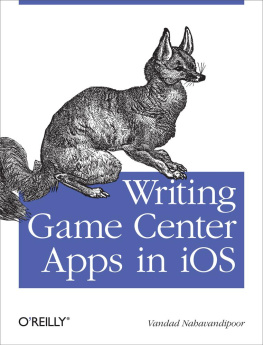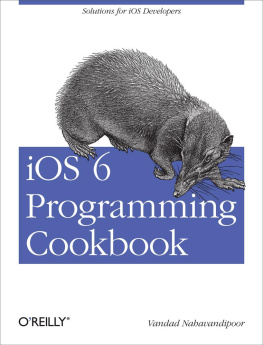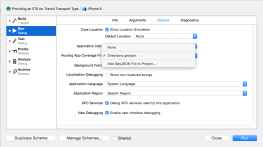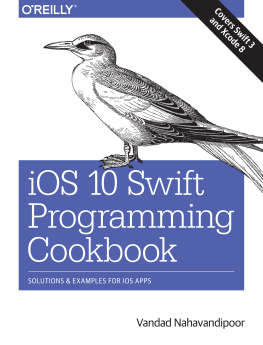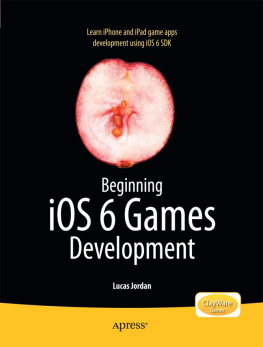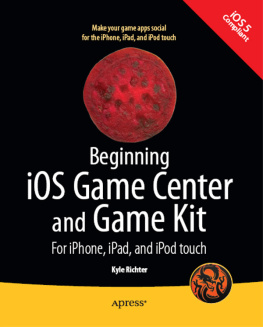Vandad Nahavandipoor - Writing Game Center Apps in iOS
Here you can read online Vandad Nahavandipoor - Writing Game Center Apps in iOS full text of the book (entire story) in english for free. Download pdf and epub, get meaning, cover and reviews about this ebook. year: 2011, publisher: OReilly Media, genre: Computer. Description of the work, (preface) as well as reviews are available. Best literature library LitArk.com created for fans of good reading and offers a wide selection of genres:
Romance novel
Science fiction
Adventure
Detective
Science
History
Home and family
Prose
Art
Politics
Computer
Non-fiction
Religion
Business
Children
Humor
Choose a favorite category and find really read worthwhile books. Enjoy immersion in the world of imagination, feel the emotions of the characters or learn something new for yourself, make an fascinating discovery.
- Book:Writing Game Center Apps in iOS
- Author:
- Publisher:OReilly Media
- Genre:
- Year:2011
- Rating:4 / 5
- Favourites:Add to favourites
- Your mark:
- 80
- 1
- 2
- 3
- 4
- 5
Writing Game Center Apps in iOS: summary, description and annotation
We offer to read an annotation, description, summary or preface (depends on what the author of the book "Writing Game Center Apps in iOS" wrote himself). If you haven't found the necessary information about the book — write in the comments, we will try to find it.
Learn how to integrate Game Center features directly into your iPhone and iPad apps with the recipes in this short and concise cookbook. Each recipe gives you the solution and the code for adding features such as leaderboards, user authentication, achievements, multiplayer games and many others, using Apples GameKit framework in the iOS SDK.
Writing Game Center Apps in iOS — read online for free the complete book (whole text) full work
Below is the text of the book, divided by pages. System saving the place of the last page read, allows you to conveniently read the book "Writing Game Center Apps in iOS" online for free, without having to search again every time where you left off. Put a bookmark, and you can go to the page where you finished reading at any time.
Font size:
Interval:
Bookmark:

Beijing Cambridge Farnham Kln Sebastopol Tokyo
Supplemental files and examples for this book can be found at http://examples.oreilly.com/0636920020349/. Please use a standard desktop web browser to access these files, as they may not be accessible from all ereader devices.
All code files or examples referenced in the book will be available online. For physical books that ship with an accompanying disc, whenever possible, weve posted all CD/DVD content. Note that while we provide as much of the media content as we are able via free download, we are sometimes limited by licensing restrictions. Please direct any questions or concerns to .
The following typographical conventions are used in this book:
Indicates new terms, URLs, email addresses, filenames, and file extensions.
Constant widthUsed for program listings, as well as within paragraphs to refer to program elements such as variable or function names, databases, data types, environment variables, statements, and keywords.
Constant width boldShows commands or other text that should be typed literally by the user.
Constant width italicShows text that should be replaced with user-supplied values or by values determined by context.
This icon signifies a tip, suggestion, or general note.
This icon indicates a warning or caution.
This book is here to help you get your job done. In general, you may use the code in this book in your programs and documentation. You do not need to contact us for permission unless youre reproducing a significant portion of the code. For example, writing a program that uses several chunks of code from this book does not require permission. Selling or distributing a CD-ROM of examples from OReilly books does require permission. Answering a question by citing this book and quoting example code does not require permission. Incorporating a significant amount of example code from this book into your products documentation does require permission.
We appreciate, but do not require, attribution. An attribution usually includes the title, author, publisher, and ISBN. For example: Writing Game Center Apps in iOS by Vandad Nahavandipoor (OReilly). Copyright 2011 Vandad Nahavandipoor, 978-1-449-30565-9.
If you feel your use of code examples falls outside fair use or the permission given above, feel free to contact us at .
Safari Books Online is an on-demand digital library that lets you easily search over 7,500 technology and creative reference books and videos to find the answers you need quickly.
With a subscription, you can read any page and watch any video from our library online. Read books on your cell phone and mobile devices. Access new titles before they are available for print, and get exclusive access to manuscripts in development and post feedback for the authors. Copy and paste code samples, organize your favorites, download chapters, bookmark key sections, create notes, print out pages, and benefit from tons of other time-saving features.
OReilly Media has uploaded this book to the Safari Books Online service. To have full digital access to this book and others on similar topics from OReilly and other publishers, sign up for free at http://my.safaribooksonline.com.
Please address comments and questions concerning this book to the publisher:
| OReilly Media, Inc. |
| 1005 Gravenstein Highway North |
| Sebastopol, CA 95472 |
| 800-998-9938 (in the United States or Canada) |
| 707-829-0515 (international or local) |
| 707-829-0104 (fax) |
We have a web page for this book, where we list errata, examples, and any additional information. You can access this page at:
| http://www.oreilly.com/catalog/0636920020349 |
To comment or ask technical questions about this book, send email to:
For more information about our books, courses, conferences, and news, see our website at http://www.oreilly.com.
Find us on Facebook: http://facebook.com/oreilly
Follow us on Twitter: http://twitter.com/oreillymedia
Watch us on YouTube: http://www.youtube.com/oreillymedia
I would like to open the Acknowledgments section of this book with a sentence by Napoleon Hill:
We are what we are, because of the vibrations of thought which we pick up and register, through the stimuli of our daily environment.
Hence, I would like to quickly say thank you to all those who have helped me become the person I am today. Thank you to Andy Oram and many thanks to Brian Jepson for their continuous support and many hours they put into working on new projects with me. I am truly grateful.
I thank Gretchen Giles, Betsy Waliszewski, and everybody at OReilly for recently contributing $200K to the Japanese Red Cross Society. I am truly honored to have been a part of this. This reminds me to thank Simon Whitty, Shaun Puckrin, Sushil Shirke, Gary McCarville, Kirk Pattinson, and all other colleagues of mine for being a continuous source of inspiration.
Last but not least, thank you for deciding to read this book and becoming a part of OReillys new and unique way of publishing technology books. I am glad I am a part of this and that I can share my knowledge, in this case about Game Center in iOS, with you wonderful readers.
Game Center is the Apple technology that allows game developers to integrate leaderboards, achievements, and multiplayer support, among other things, into their iOS apps. Why is it so important? Simply because Apple takes care of the server infrastructure of Game Center for you! Apple also provides iOS developers with a framework, called GameKit, to make Game Center integration into iOS Apps really easy.
You want to learn how to use block objects and Grand Central Dispatch so that you can write Game Center apps in iOS.
Learn the basics of block objects and Grand Central Dispatch here.
All of us, at some point, have used threads. We use threads to separate the paths of execution in our code and to give priority to certain paths of execution over others. A classic example of this is the main UI thread in every iOS application. All iOS developers are encouraged to avoid keeping the UI thread busy for work that is non-UI-related, in order to sustain a responsive user interface. Therefore, all work that is not UI-related can, and indeed should, be executed in separate threads.
With the introduction of multicore mobile devices such as the iPad 2, threads and their management have become more complicated than ever before. Not only should developers know what path of execution is running at any instance, they should also know which core of the processor that path is running on in order to utilize the power of the multicore processor. To simplify matters, Apple made available, to iOS and OS X developers, an excellent set of APIs wrapped in a library named Grand Central Dispatch (GCD). GCD allows developers to simply focus on the code that has to be executed and forget about the dirty work that needs to be carried out in order to balance the work among multiple threads on a device that can have multiple cores.
Font size:
Interval:
Bookmark:
Similar books «Writing Game Center Apps in iOS»
Look at similar books to Writing Game Center Apps in iOS. We have selected literature similar in name and meaning in the hope of providing readers with more options to find new, interesting, not yet read works.
Discussion, reviews of the book Writing Game Center Apps in iOS and just readers' own opinions. Leave your comments, write what you think about the work, its meaning or the main characters. Specify what exactly you liked and what you didn't like, and why you think so.

